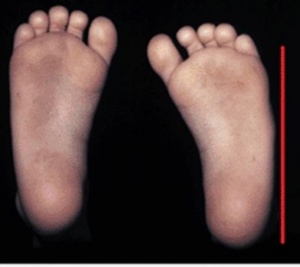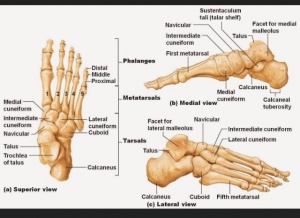Metatarsus Adductus: Difference between revisions
m (Picture added) |
Kim Jackson (talk | contribs) (Corrected reference errors) |
||
| Line 22: | Line 22: | ||
The skeleton of the foot is made of the thirty three bones, twenty six six joints and over a hundred muscles, ligaments and tendon. The foot serves primarily as a weight-bearing joint and provides a stable base of support on which to stand. Ligaments are attached to the bones which creates joints. The anatomy of the foot is divided into 3 categories: the ''Forefoot'', the ''Midfoot'' and the ''Hindfoot''. | The skeleton of the foot is made of the thirty three bones, twenty six six joints and over a hundred muscles, ligaments and tendon. The foot serves primarily as a weight-bearing joint and provides a stable base of support on which to stand. Ligaments are attached to the bones which creates joints. The anatomy of the foot is divided into 3 categories: the ''Forefoot'', the ''Midfoot'' and the ''Hindfoot''. | ||
'''Hindfoot is comprised of :''' Tibiofibular joint , Talocular joint and the Subtalar (Talocalcanean) joint.<ref name=":0 | '''Hindfoot is comprised of :''' Tibiofibular joint , Talocular joint and the Subtalar (Talocalcanean) joint.<ref name=":0">Magee, D. J. (2008). Orthopedic physical assessment. St. Louis, Mo: Saunders Elsevier.</ref> | ||
'''Midfoot (Midtarsal Joints) is comprised of:''' Talocalcaneonavicular Joint, Cuneonavicular Joint, Cuboideonavicular Joint, Intercuneuform Joints, Cuneocuboid joint and the Calcaneocuboid Joint.<ref name=":0 | '''Midfoot (Midtarsal Joints) is comprised of:''' Talocalcaneonavicular Joint, Cuneonavicular Joint, Cuboideonavicular Joint, Intercuneuform Joints, Cuneocuboid joint and the Calcaneocuboid Joint.<ref name=":0" /> | ||
'''Forefoot is comprised of:''' Tarsometatarsal Jointts, Intermaetatarsal Joint, Metatarsophalangeal Joints and Interphalangeal Joints.<ref name=":0 | '''Forefoot is comprised of:''' Tarsometatarsal Jointts, Intermaetatarsal Joint, Metatarsophalangeal Joints and Interphalangeal Joints.<ref name=":0" /> | ||
== Epidemiology and Etiology == | == Epidemiology and Etiology == | ||
There is an incidence of 1 in 100 to 1 in 5,000 live births.<ref | There is an incidence of 1 in 100 to 1 in 5,000 live births.<ref name=":2">Wildhe T.Foot deformities at birth: a longitudinal prospective study over a 16 year period. J Pediatric Orthopedic. 1997;17(1):20-24</ref> The cause of metatarsus adductus remains unknown. It is however, thought to be related to intrauterine compression. Family history may also be a causative factor. Other theoriespof causal relation includes abnormal tendon insertion of tibialis anterior, tibialis posterior and abductor hallucis muscles.<ref name=":3">Hassan N, Roger J (2015) Management of Metatarsus Aductus, Bean-Shaped foot, residual clubfoot adduction and Z-shaped foot in children, with conservative treatment and and double column osteotomy of the first cuneiform and cuboid. Ann Orthop Rheumatol3(3):1050.</ref> | ||
== Clinical Presentation == | == Clinical Presentation == | ||
| Line 62: | Line 62: | ||
<br> | <br> | ||
== References == | == References == | ||
<references /> | |||
Revision as of 00:23, 20 April 2019
Original Editor - Shaniel Walters
Description[edit | edit source]
Metatarsus Adductus ( Hooked Foot)[edit | edit source]
Common foot deformity seen in children which causes the foot to turn inwards. The foot appears "c-shaped. This condition is often associated with hip dysplasia.
Types[edit | edit source]
Metatarsus Adductus may be classified as:
Flexible: Presents with adduction of the 5 metatarsal bones at the tarsometatarsal joint.
Rigid: Presents with medial subluxation of the tarsometatarsal joints. There is valgus of the hindfoot and the navicular is later to the head of the talus.
Clinically Relevant Anatomy
[edit | edit source]
The skeleton of the foot is made of the thirty three bones, twenty six six joints and over a hundred muscles, ligaments and tendon. The foot serves primarily as a weight-bearing joint and provides a stable base of support on which to stand. Ligaments are attached to the bones which creates joints. The anatomy of the foot is divided into 3 categories: the Forefoot, the Midfoot and the Hindfoot.
Hindfoot is comprised of : Tibiofibular joint , Talocular joint and the Subtalar (Talocalcanean) joint.[1]
Midfoot (Midtarsal Joints) is comprised of: Talocalcaneonavicular Joint, Cuneonavicular Joint, Cuboideonavicular Joint, Intercuneuform Joints, Cuneocuboid joint and the Calcaneocuboid Joint.[1]
Forefoot is comprised of: Tarsometatarsal Jointts, Intermaetatarsal Joint, Metatarsophalangeal Joints and Interphalangeal Joints.[1]
Epidemiology and Etiology[edit | edit source]
There is an incidence of 1 in 100 to 1 in 5,000 live births.[2] The cause of metatarsus adductus remains unknown. It is however, thought to be related to intrauterine compression. Family history may also be a causative factor. Other theoriespof causal relation includes abnormal tendon insertion of tibialis anterior, tibialis posterior and abductor hallucis muscles.[3]
Clinical Presentation[edit | edit source]
The forefoot is adducted and sometimes supinated , but the midfoot and hindfoot are normal. There is convexity of the lateral border of the foot, with concavity of the medial border. Older children may present with an in-toeing gait.
Diagnostic Procedures[edit | edit source]
add text here relating to diagnostic tests for the condition
Management / Interventions
[edit | edit source]
Specific treatment for metatarsus adductus is often determined by the following factors:
- Child's Age
- Medical History
- Extent of the condition
- Tolerance for the specific procedure
- Expectations for the condition
Interventions include:[edit | edit source]
- Passive Stretching
- Passive Manipulation exercises
- Stretching
- Serial Casting
- Footwear
- Surgery to release the joints
Prognosis[edit | edit source]
Generally excellent. Most cases of metatarsus adductus often resolves on its own
References[edit | edit source]
- ↑ 1.0 1.1 1.2 Magee, D. J. (2008). Orthopedic physical assessment. St. Louis, Mo: Saunders Elsevier.
- ↑ Wildhe T.Foot deformities at birth: a longitudinal prospective study over a 16 year period. J Pediatric Orthopedic. 1997;17(1):20-24
- ↑ Hassan N, Roger J (2015) Management of Metatarsus Aductus, Bean-Shaped foot, residual clubfoot adduction and Z-shaped foot in children, with conservative treatment and and double column osteotomy of the first cuneiform and cuboid. Ann Orthop Rheumatol3(3):1050.








